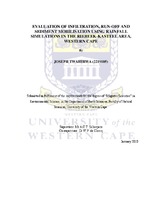| dc.description.abstract | The project was conducted on a small-scale catchment at Goedertrou in the Riebeek- Kasteel district. The focus of this study was to address some of the hydrological processes active in the research catchment, namely infiltration, run-off and sediment mobilisation on different soil types. It was done to investigate the origin of Berg River pollutants. To answer the overall question about what influence the natural salt load of the Berg River, a number of subprojects have been identified, one of which is to understand the hydrological processes in the soil mantle and vadose zone. Hence, the study aimed to answer the research questions mentioned and discussed in section 1.3 of Chapter 1. Considering the results, it could be suggested that decayed root systems from the rows of plants, soil cracks, small channels and openings created by small animals, as well as slope orientation and, therefore, soil composition, all played a major role in influencing the ability of the soil to absorb the simulated rainfall. In this study, the factors that influenced run-off are micro topography, soil moisture, root system, animal activities in soil profile, soil crack dimensions and the hydraulic conductivity. The main factors that played a major role to influence sediments mobilisation are strongly believed to be the micro topography within the ring, slope gradient and length, vegetation cover and rainfall-simulation intensity. After using different techniques, the results show that farmers must be aware that with storm rainfall, particles smaller than 65 μm are subject to mobilisation. It is important to let land-users know that they need proper and appropriate methods for land-use. | en_US |

